On Sat. Dec. 11 at the end of the first week of my residency at Showa, I woke up and 7 AM and worked on my computer for several hours. It was a free day with no lessons and only rehearsals scheduled for the afternoon. From noon until 5 PM I was involved in a run-through of next week’s concert, which will be a very important one for Kaz and for Showa. Kaz’s students have been winning competitions and drawing attention to the Showa percussion scene. This will be the first all-percussion concert in the school’s big opera house (Teatro Giglio) and lots of percussion people from other conservatories will attend. It will be a huge recruitment event, even as the current 50-student percussion department continues to grow in number and in capability.
The rehearsal for the 2-hour program involved managing and moving literally several hundred instruments and stands into setups between pieces in as short a time a possible. Yashio has spent weeks preparing responsibilities for each student, and the rehearsal in the large band room was the only available place large enough to have a run-through, because the Teatro Giglio was set up for “The Messiah” all week, and next Sunday’s pre-concert time will be filled with lighting and sound setups and checks.
As appears to be typical, based on past visits, the program is aimed at a general audience (rather than on the more serious music aficionados we usually see at home), so there are some very light pieces, dancers, lots of loud/fast drumming, some Christmas carols, and a rhythmic “pots-’n-pans” encore. But there is also the fantastic Revueltas piece, “La Noche de Los Mayas.”
Sunday December 12 was also sunny and mild. It was another day of rehearsing for the final gala concert, I am involved in two pieces on the concert – the “March for Two Kettledrums” by A. Phildor, which I have arranged for 5 timpanists, and “Agbekor” for a quasi-African drum ensemble using available congas, bongos, and tom-toms. At the end of the day’s work Kaz, Yashio and I drove in heavy rush hour traffic for about 90-minutes to the Monterey Hotel in Yokohama.
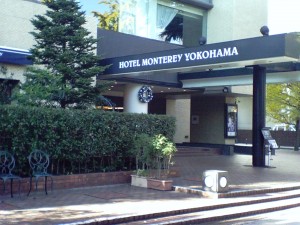
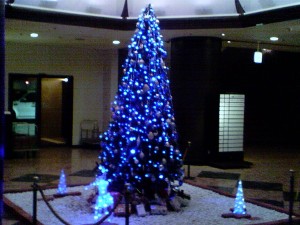
The minor inconvenience of having to repack was offset by the chance to have a change of scenery. Even though I’ve visited Yokohama before, I was again impressed by the city, especially at night – tree-lined boulevards, lots of neon, a beautiful harbor. My hotel was located on a wide boulevard right on the Bay. There are lots of Christmas lights everywhere, even in the hotel lobby. After checking into my very comfortable but efficient room, Kaz, Yashio and I walked about 10-minutes to nearby Chinatown and a very fine high-end Chinese restaurant that is a favorite of Yashio’s. We were joined there by their son, Tomoshige, who is currently a dentistry student in Yokohama. The dishes selected by Yashio were incredible – as good as I remember from the NEXUS visits to Taiwan – thin-sliced fresh veggie strips in a very light lemon/sesame seed vinaigrette, marinated eggs, sesame chicken slices, a crusted shrimp/tofu ball, a rolled jumbo shrimp, egg fried rice, and a fruit & lychee desert, served with Kaz’s favorite Kirin beer and a very sweet dark Chinese sake.
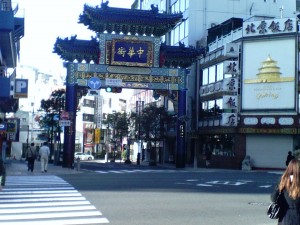
At dinner I told Kaz that I’m thinking of making reductions in all of my future commitments and he wasn’t at all surprised. He hinted, though he might just have been trying to be nice, that he was thinking of inviting both Ruth and me again next December. I thanked him, but replied that I didn’t know what our plans would be. On a related note Kaz and Yashio said they’re thinking of coming to the Percussion Rochester event next May.
The next morning (Monday) was beautifully sunny and clear in Yokohama, so I took the opportunity to walk around for about 30-minutes taking a few photos before checking out of the Monterey Hotel.
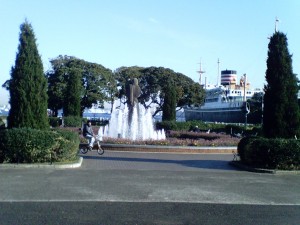
Yashio picked me up at the hotel at 9:30 AM and we drove back to the Hotel Molino in Shin-Yuri, where I dropped off my bags before heading over to the school. The Monday schedule consisted of five lessons. I’ve been amazed that my pickyness about ‘gremlins’ seems to finally have had a significant effect in reducing the stand and instrument rattles at Showa. There hasn’t even been even one pedal bass drum stuffed with a blanket.
At the lunch break I walked over to the Molino Hotel and checked in. Then I ran over to the Mylord department store to buy a nice sake for the evening’s dinner at Sadanari’s before running back to school for the afternoon lessons. After school Kaz drove us (Yashio, me and Ko, a 4th-year student) to Seichiro and Tokiko Sadanari’s home in Setagaya. We were joined by their son, Kungo Sadanari, who had been my interpreter at Showa some years ago, and who had recently moved out of crowded Setagaya to an area in the mountains about 2-hours from Tokyo because he thought it might be healthier for his family. There’s a sense of resignation in Japan about the nuclear stuff, but underneath the stoicism there’s an unspoken concern and a suppressed longing for more information. The March earthquake seems to come into lots of Yashio’s and Kaz’s conversations. Seichiro told us that he had just driven home from Fukushima when the earthquake struck and his car was rocking wildly during the event. Kungo said he could see the concrete roads rolling in wave-like motions as if the highways were liquid. A conga drum in Kungo’s house had been tipped over and it had rolled back and forth from one side of the room to the other.
Seichiro’s chicken curry, as usual, was very good as were Tokiko’s appetizers – Waldorf salad, cheese bites, bean sprout salad and salmon with onions. The dinner conversation included the inevitable stream of jokes and stories and everyone seemed to have a good time as usual. And then, after saying our sayanaras, Ko escorted me in a taxi to Machida Odakyu Station to catch a 15-minute train ride back to Shin-Yuri Gaoka Station next to the Hotel Molino.
Tuesday Dec. 13 was just another “day at the office”. I finally slept until 8 AM, and it was clear and sunny again for my walk.
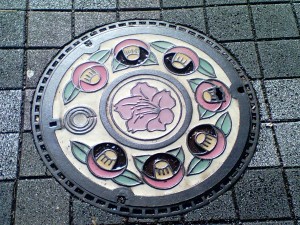
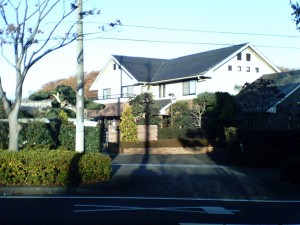
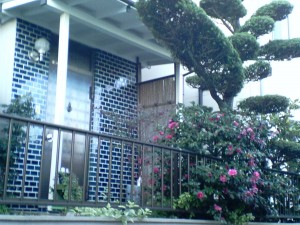
I’ve noticed on my walks that the streets are virtually free of litter and that the small gardens are well manicured. I also see people walking their dogs – large and small and even a Westie or two.
By the time I went over to the school around 10:30 it was warm enough not to need an overcoat. There were only 4 lessons scheduled, so I finished early at 3:30 and then went over to the department store to buy some blank DVDs so that I could make dubs of one of the lessons that I video-recorded last week – a nice marimba/vibes duo titled, “Toccata” by Anders Koppel played by Ayaka and Erika. I’ll give each of them a DVD.
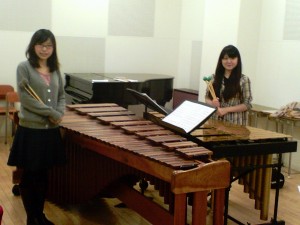
In the department store’s music section, I also noticed a new DVD on the NHK label by the Berlin Philharmonic conducted by Yutaka Sado, the same conductor who conducted NEXUS in Hyogo in October 2010. The DVD included “From me flows what you call Time” and the price was expensive – ¥4950.
Wednesday Dec. 14 made up for t the previous easy day; there were 7 lessons – 10 AM to 5:30 with an hour lunch break. I woke up at 7 AM to a rainy morning but by the time I finished emails and went out to do my walk the rain was over, though it was definitely colder. My emails basically had to do with the Governance Committee of the Rochester Philharmonic Orchestra. There were issues relating to qualifications to be on the Honorary Board (of which I am the current Chair). I suspect there were some politics at play having to do with non-RPO business/social relationships in Rochester, but I tried in my emails to remain focused on what’s best for the RPO, as opposed to what’s best for the Honorary Board. (“511” !?)
On this seven-lesson day, one big surprise was when Yuki, a freshman, came in and played “Side-By-Side” as well, if not better, than I’ve ever heard it – Eastman included. Fortunately, she agreed to play it through again and let me video record it, which I did.
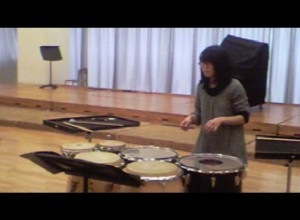
The translator, Ms. Iishi, couldn’t attend this day because of another commitment, so Kaz was with me all day. His translations probably weren’t as accurate as Ms. Iishi’s, but we did the best we could and it worked out fine.
Another highlight was the last lesson at 4:30. Erika, a grad student, played the Mayazumi “Concertino for Xylophone and Orchestra” accompanied by another grad student, Yuka Chiba, playing her own orchestration on an electronic organ. Erica used a marimba instead of a xylophone and the keyboard orchestra samples on the electronic organ worked very well.
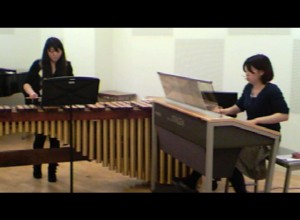
I think it’s an ideal use of the electronic organ’s capabilities. The sound is not 100-percent like an orchestra, but it’s quite good (80-percent?) and much more interesting than a piano, and arguably closer to the composer’s original intent. For a student recital or jury, it makes so much sense to me, but I know that it would take an awful lot of persuasion to overcome the prejudices of the traditionalists.
Back at the hotel in the evening I watched world-class around-the-world yacht racing on wide-screen Japanese TV with “tack-by-tack’ commentary in Japanese that I didn’t understand, but the scenery was interesting anyway – especially the on-board camera angles.
Thursday Dec. 15 might accurately have been called “Jolivet Percussion Concerto Day” at Showa. There were five lessons on various movements of this very dated piece, the last movement of which, with its machine-gun snare drum rimshots, is incredibly strange to my sensibilities, but my job is not to be judgmental; it’s to be encouraging, and I did my best to help the students get the most out of my observations. After lunch there was also an African ensemble rehearsal. We played once through “Agbekor” and it went without a hitch, so the rehearsal ended early. Again this year I was asked at the last minute to address the monthly faculty/administration meeting in the afternoon, so at lunch I trotted back to the hotel to get a tie and jacket and to make some quick notes on my talking points, which I delivered to a room full of about 200 people:
– I thanked Kaz, Yashio, and Fumiko (translator),
– I expressed my compassion for those who suffered in the earthquake disaster and reported that many of my friends in Rochester and Canada were shocked and made donations to the recovery efforts,
– I reported that the freshmen this year were the best ever, and that the level increases every year,
– I thanked the administration for supporting this Sunday’s percussion concert in the large theater (for the first time)
– I expressed by belief that music is a powerful force for good in fostering understanding, and I congratulated the Showa faculty and administration for their good work
Then the lessons continued until 6 PM. Afterwards as I walked back to the hotel a middle-aged lady came running up to me shouting “Cahn-sensei”. It was Toshie, who was Kaz’s senior assistant back in 1999, when Ruth and I both went to Showa at the old campus in Atsugi. Toshie, whom I would never have recognized, was on her way to Showa for a rehearsal of the Giglio Orchestra, comprised mostly of Showa alumnae. We exchanged regards and off she went.
After a long day I thought I’d treat myself to a nice restaurant dinner with some wine. I know of only three decent restaurants in the Shin-Yuri area – one in the hotel (very expensive – I’ve never eaten there), a good sushi restaurant about a mile away, and an Italian Trattoria in the Shin Yuri Plaza, where I’ve gone in years past and where they also have good gnocchi dishes and a decent wine list. However, for some reason the restaurant was closed, so I’d have to try again another day.
Friday the 16th was the last day of lessons and it seemed to go by very quickly. The most interesting lesson of the day – and maybe of the entire two week residency – was an hour on the Bartok Sonata with four grad students Yu on the timpani part, Shiyono on the xylo part and two twin brothers, Tatsuya and Fumiya on pianos. It was their fourth rehearsal, so they sort of knew the piece, but there were still gaps in their listening, so basically, I tried to help them to know where to listen – sometimes to Piano 1, sometimes to the timpani, etc.
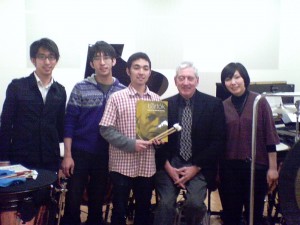
The last lesson of the day was Shiyono, the same grad student who was in the Bartok. She played the Elliot Carter “March” and then a very nice etude from the Kruger book, all done with good sound and confidence. Interestingly, she had the timps set up in the German style. I asked her why, and she said that she wanted to study in Germany, because she had been at the Bayreuth Festival last summer, and had even played in the study orchestra there. Amazing! I remember when Shiyono was a very wide-eyed shy freshman, and now she’s a poised, worldly young lady. I wouldn’t be surprised if she ends up as timpanist in a German orchestra someday.
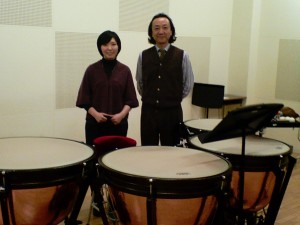
The lessons ended at 4:30 PM and I went down to the office to pick up my payment. This happens in a kind of ritual that I have experienced in all of my past visits. I am escorted to a meeting room by two of the office personnel (one the finance officer and the other, I guess, is simply a witness to the transaction). There are a few forms and receipts to sign and then the cash envelop is handed to me along with a suggestion that I count the money, and of course, I always decline to count it.
At 5:00 Kaz had to go to conduct a rehearsal of the Revueltas, so I took off and went back to the hotel. At 6 PM I walked over to Shin-Yuri Plaza and that nice Italian restaurant which was closed the day before. It was open, so I walked in and was seated at a long bar. I ordered the gnocchi with ham, walnuts, green beans and Gorgonzola sauce along with an order of garlic bread and a glass of the house red wine. It was definitely a welcome change from my regimen of sushi and rice dishes over the last 10-days.
Back in the hotel after dinner I watched a TV documentary about the Barnes Gallery in Philadelphia and the wonderful collection of masterpieces, mostly of the French impressionists. Ruth and I spent a nice afternoon at the Barnes maybe 20-years ago. The paintings are hung close together – floor to ceiling and wall to wall – making a dense, but interesting juxtaposition of artists and styles.
Saturday Dec. 17 was the dress rehearsal day for the big Sunday afternoon concert. After responding to emails in the morning I walked over to the Plaza and got an Egg McMuffin and coffee at the McDonald’s in the train station. Then I worked on this blog posting and walked over to the Mylord Department Store to buy the sayanara presents for Kaz, Yashio, Fumiko (translator) and Ko (senior student mentor).
At noon I headed over to Showa for the dress rehearsal. The program is:
1) Opening music – 6 freshmen free improv in balcony as audience enters
2)”DTKT” by G. Joyce – duet on 12 tom-toms
3) “Entrada” by G. Joyce – duet on marimba and vibes
4) “Energico” by Kaz Meguro – 5 percs on drums with dancers
5) “March for Kettledrums” by Philidor – Cahn & 4 seniors on timps
6) “Nimrod” by Elgar – arranged for marimba ensemble
7) “Symphony No. 25” by Mozart – arranged for marimba ensemble
8) “Oye Como Va Puente, arr. by D. Quin) – for marimba ensemble
9) “Agbekor” – Cahn with African perc ensemble
INTERMISSION
10) “Symphony of Psalms” by G. Hughes
11) “Rebana Loops” by D. Pye
12) “La Noche de Los Mayas” by S. Revueltas – arr. for marimbas & electronic organs
13) “Evening Prayer” by Humperdinck – arranged for marimba ensemble
14) “Kitchen Sink” by D. Gilles – marimba ensemble w/ kitchen utensil percussion
15) “Silent Night” – handbell ensemble
One thing (among many) that differentiates the programs at Showa (and in Asia) with the programs at Western conservatories is that these programs are aimed at the general (ie. unsophisticated) public, so there is always music that would be considered “beneath’ non-Asian conservatory audiences (eg. “Kitchen Sink”). It will be interesting to see how many people actually turn out for the Sunday concert.
The rehearsals in the large band room had already started and the stage manager was double-checking every detail with Yashio as the staging was rehearsed in program order.
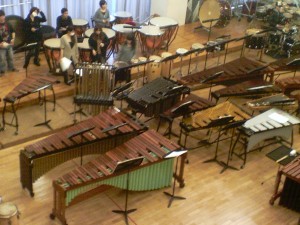
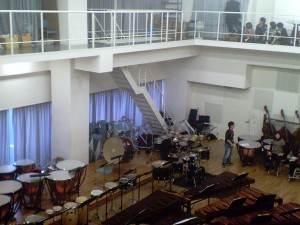
Every one of the forty-five students has some responsibility to move instruments between pieces, and the changes were all carefully timed with a stop watch to be under a minute. My rehearsal of the Phildor started at 2 PM. The four students – Aiko, Yu, Shiono, and Ikumi – tried to play their parts from memory, but in the end it was determined that the music stands would stay, in as low a position as possible. At 3:15 or so the Agbekor rehearsal started. As the students carried out my drum to setup at center stage, Ko (the senior monitor and big brother) approached Yashio and a lengthy conversation ensued. Ko had noticed that it seemed out of etiquette for the short girls (namely, every girl in the percussion department) to be moving the big conga and stool, while the guys were standing around. Of course, the girls normally move everything between studios for lessons and rehearsals. They routinely do it, but not in front of paying audiences. When the planning huddle ended, the guys moved my conga and stool into position, then left the stage, and reentered with the line of 18 freshmen and sophomores (mostly girls), each carrying his/her drum, followed by me walking into place carrying a djembe. Once in place I played a few solo calls, and then the opening call to begin the piece before changing to the conga drum, serving as a surrogate adzimevu (master drum).
One of the pieces on the second-half is “Rebana Loops” by David Pye, an Australian. I had not heard it at all before this rehearsal and when it began I did a mental double-take, because it sounded remarkably similar to the piece that Ivan Trevino wrote – the one that won first-place in the PAS composition contest. Of course it was different, but it took me a while to be certain of it. The minimal patterns also reminded me of recent pieces I’ve heard by Marc Mellits.
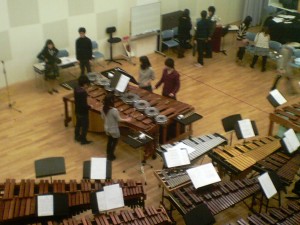
“Rebana Loops” is for four players on two 5.0 marimbas placed face-to-face, with a line of eight roto-toms placed in a row between the two marimbas. This and all of the other student pieces were played very well and the rehearsal ended at 5 PM.
On the walk back to the hotel there was music coming from the Shin-Yuri Plaza, and a crowd had formed around a stage area to watch a program, that as it turned out, was produced by Showa students. A soprano was singing “O Danny Boy” a-cappella, and a children’s chorus was standing by ready to go on. As I walked past I was introduced to a girl student (clarinetist, I think) who auditioned for Ruth at Eastman last year while I was here at Showa. Unfortunately, I didn’t get her name.
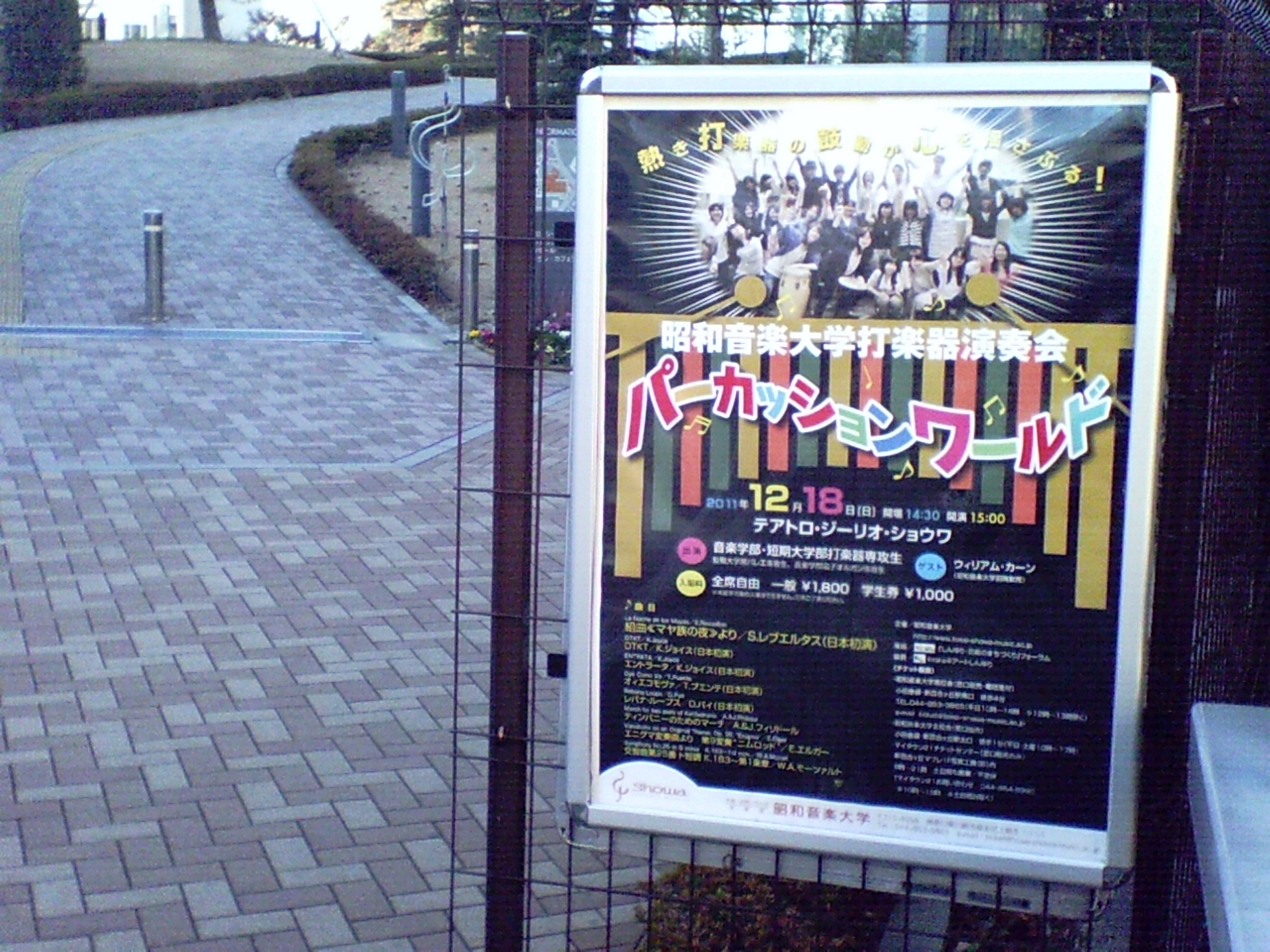
Sunday the 18th finally arrived and it started with a final walk at 7:30 AM. The morning dress rehearsal in the big hall went smoothly. Tomomi Yamashta (who visited the “Drum Boogie ’09’ with Kaz) and Megumi, another graduate from several years ago came to the concert and reception. The concert audience was very good – about half a house, but it’s a large hall – and everyone was pleased, because this was a first-time event and no one knew for sure how many people would buy tickets. The students played exceptionally well – so well, in fact that I really have a sense that my work here is done.
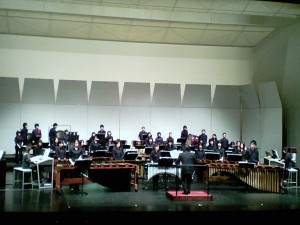
Kaz’s arrangement of the Revueltas “La Noche de Los Mayas” was really great. I’d love to hear this piece performed by an orchestra. However, short of that, the electronic organs were very good. I met Mr. Agata (the Yamaha representative who visited Eastman simultaneously with Kaz in ’09) at intermisson and he was very happy. There was a very nice post-concert reception at Il Campiello (the gelato cafe) with sandwiches, salads and wine. As usual, I was asked to say a few words so I congratulated all of the students on their great performamces, and wished all of them good luck. I said a ‘Campai” to Kaz and Yashio, and the students presented me with a small gift. Then there were the photos – with the “V” fingers, of course – and the final “sayanaras.” Rather than go the the second reception, I decided to return to the hotel to get started on packing and final emails. Kaz and Yashio will also be staying at the Molino Hotel tonight after a long day, to avoid the drive to and from from Yokohama to pick me up in the morning. Tomorrow we’ll all check out at 10 AM and drive to Narita for my flights back to Rochester.
I’ve done my best while here in Japan to take in as much of the experience as possible, and I’ve been reminded that some things can’t really be put into words – the smells encountered on the streets, the neon at night, the expressions on people’s faces, the look on a students’ faces when told that they’ve done well, the “Jap-lish” expressions printed on T-shirts, the shared laughter with good friends. I don’t know if I’ll ever (at this age) be returning to Japan again, so I’m leaving with a deep sense of sadness, and yet a profound gratitude for the numerous moments shared with so many friends and students since my first visit in 1976.
